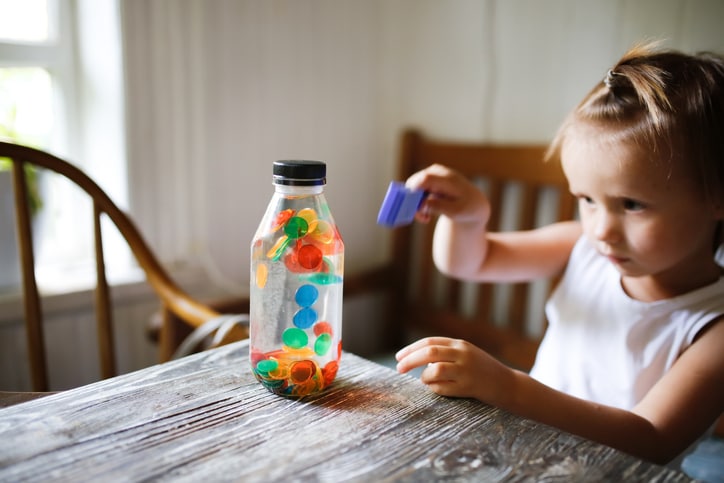It seems like there’s always a hot new toy on the market, from dissolvable eggs that hatch tiny creatures to slimes and squishies that are just begging to ruin a couch. One popular toy over the last several years has been water beads. The tiny polymer balls swell up when soaked in water and create a fun sensory experience many kids enjoy. But a slew of concerning stories and a robust study on rising hospitalizations due to water beads has left many parents with one question: Are water beads dangerous?
One Pennsylvania mom found out the hard way that while fun, water beads also come with risk. Valerie made a water bead sensory bin for her elementary-aged child. Afterwards, the girl stuck a few dry water beads in her ear without her mom knowing. The child later went swimming and was up all night crying from ear pain. A doctor pulled five engorged beads out of her ear. “We are so lucky they could get them out and she did not lose her hearing as a result,” says Valerie.
Valerie’s family no longer plays with water beads, but many parents and therapists still like to use them. As with many parenting decisions, it is important to weigh the risks versus the benefits before deciding to purchase or ban them. Here’s what experts say parents and caregivers should know about water beads, including the potential dangers and how to keep kids safe.
What are water beads?
When parents purchase water beads (sometimes called Orbeez, a brand name for one version of the product), they look like couscous or sprinkles — tiny, colorful balls. The small orbs are made of polymers that can absorb large amounts of liquid. That property means that while the beads start small, they don’t stay small.
“Water beads are made from super-absorbent material that can swell to hundreds of times their original size when exposed to fluids,” says Dr. Gary Smith, founder and director of the Center for Injury Research and Policy at Nationwide Children’s Hospital in Columbus.
The orbs have become popular in sensory play, crafts, “gel blaster” guns that launch water beads and sometimes even in flower arrangements to retain moisture. Parents and teachers also fill bowls or water tables with the little squishy spheres, and they are particularly helpful for kids who may struggle with sensory processing needs.
“Water beads can be a great preparatory activity for pre-writing or handwriting skills, as they will wake up the sensors and muscles of the hands,” says Jessica Addeo, an occupational therapist and nervous system clinician.
“Water beads in dehydrated form are small and often sold in sets of tens of thousands. This means that they can be easily spilled or misplaced, and may not be noticed until found by a young child.”
—Dr. Gary Smith, founder and director of the Center for Injury Research and Policy at Nationwide Children’s Hospital
Are water beads dangerous?
In recent years, there has been growing concern over the safety of water beads — even leading Target to pull water bead toys from shelves. A recent study co-authored by Smith found that there were over 8,000 emergency room visits related to water beads between 2007 and 2022. Even more shocking, that number increased by 131% in just the final year of the study — a sharp uptick in medical emergencies.
“Water beads in dehydrated form are small and often sold in sets of tens of thousands,” Smith says. “This means that they can be easily spilled or misplaced, and may not be noticed until found by a young child, a group known for exploring their environment by placing objects in their mouth.”
And it isn’t only the youngest children who are at risk. “Because water beads do not pass the small parts test, they cannot be marketed for use by children younger than 3 years old,” Smith explains. “However, they are marketed to children 3 and 4 years of age as sensory products, and this age group accounted for 21% of water bead ingestions in our study.”
Common safety concerns with water beads
OK, so water beads are tiny until they get wet — why is that a problem for kids? There are several reasons the unique properties of this product make them dangerous under the right conditions. Some of the most common concerns with water beads are:
Sticking water beads in mouths, ears and noses
“Children could potentially put them in their mouth or nose, leading to a blockage in the intestine or airways,” says Dr. Hector de Leon, a pediatrician with Kaiser Permanente in Colorado. He’s even seen ingestion lead to surgery.
When kids ingest water beads, they begin growing from the moment they enter their mouth. Some water beads can swell to the size of a tennis ball, which is extremely concerning inside the body of a small child. Additionally, water bead-related blockages can be hard to diagnose since the beads may not show up on X-rays. Smith adds that water beads, while technically non-toxic, have even led to a few deaths.
“No parent wants to have their kid in the ER, so like with any activity, parental supervision is best,” says de Leon.
“Children could potentially put them in their mouth or nose, leading to a blockage in the intestine or airways.”
—Dr. Hector de Leon, pediatrician with Kaiser Permanente
Ingestion by pets
Just as toddlers are prone to feed snacks to their beloved pet from their high chair, they may slip some of their water beads to a furry friend. Pets might also ingest beads they find on the floor, which is dangerous as well. Water beads cause all of the same issues in pets as they do in humains. The Center for Pet Safety has even called for a ban on water beads.
Plumbing issues
While not nearly as concerning as medical emergencies caused by water beads, the beads are also known to clog household pipes and drains. Just a few beads that roll down a kitchen sink drain have the potential to back up the sink, garbage disposal and connected dishwasher, for example. When working with water beads, it is best to add water to them in a container at a safe distance from any drains.
Water bead safety tips
Despite the risks, some parents may choose to use water beads in a supervised setting, and they do have some benefits in a therapeutic setting. “Water beads are wonderful for tactile sensory input,” says Addeo, who uses them with clients. “Many children benefit from this type of input to help release coping chemicals that wash away adrenaline via deep touch.”
If you do decide to play with water beads, the experts suggest following these safety steps:
1. Watch closely when kids play with water beads
Young children should never be left alone with water beads. It only takes a moment for them to ingest one or stick one in their ear. Even watching your child while also cooking dinner is not enough supervision for water bead play, the experts say. If possible, sit with your child and play with them.
2. Tell kids about the risks
Older kids can understand the risks of water beads — they see them grow and expand. Tell kids what can happen to their bodies, and ask for their help to keep water bead play safe. Use a straw to demonstrate how beads can swell up in their body and cause harm. Even young toddlers can be firmly reminded to keep water beads in their bin, though they still require close supervision.
3. Don’t reuse water beads
Despite all of the other risks, water beads can also be a breeding ground for germs. They are moist and things stick to them, so it’s best to safely toss them out in a tied up bag after each play session. Given the low cost of water beads, it is not worth trying to save them for another day.
4. Watch out for signs of water bead ingestion or injury
Smith and de Leon say it can be tricky to discern if a child’s distress is caused by water beads, especially if the child is too young to communicate effectively. Signs of water bead ingestion frequently mimic other gastrointestinal ailments, including:
- Cramps.
- Vomiting.
- Pain.
It’s best to seek medical attention quickly if you believe your child or pet may have a water bead anywhere in their body.
The bottom line
There is strong data to suggest that water beads pose significant risks to children. While there are ways to mitigate that risk, there is no way to ensure that water beads are entirely safe. All water bead play needs to be closely supervised, and parents should seek medical attention if their child exhibits any signs of pain or distress after having access to water beads.
“If children younger than 6 years or individuals with developmental delays live in or visit your home, water beads should be kept out of your home,” Smith concludes. “Talk with your child care directors, preschool teachers, therapists and others who may be using water beads. Share with them that water beads are not safe to use with young children and those with developmental delays. Encourage them to use safer alternatives.”
Ultimately, each parent needs to look at the data as well as their own child’s age, maturity level and behavior before deciding whether or not to purchase water beads.




